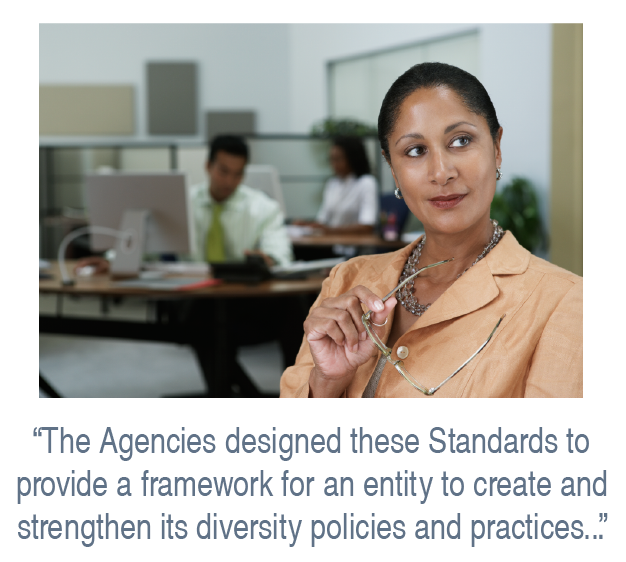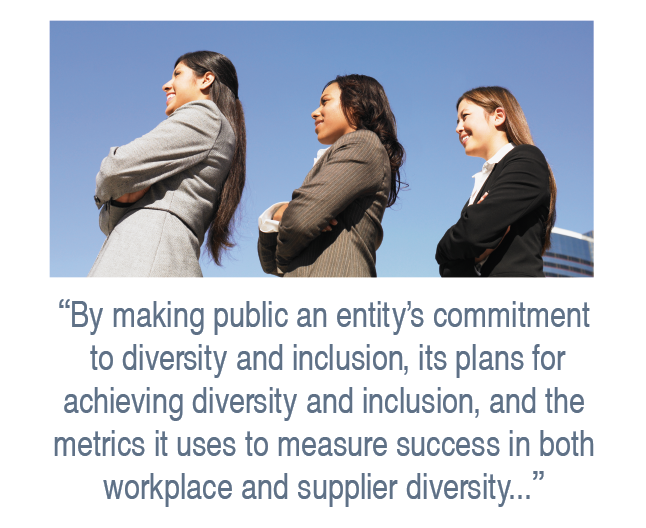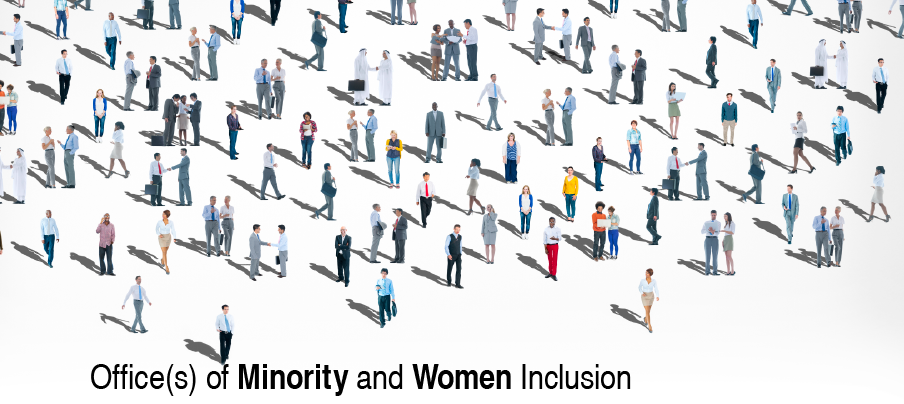Interagency Policy Statement Establishing Joint Standards for Assessing the Diversity Policies and Practices of Entities Regulated by the Agencies
After receiving more than 200 comments, and conferring with various regulated entities and professionals, six agencies issued a final statement establishing these standards in June 2015. Subdivided into five sections, each with detailed regulations, this interagency policy statement addresses the obstacles and barriers burdening minorities and women today.

I. Introduction
Section 342(b)(2)(C) of the Dodd-Frank Wall Street Reform and Consumer Protection Act of 2010 (Dodd-Frank Act) requires the Directors of the Offices of Minority and Women Inclusion (OMWI) to develop standards for assessing the diversity policies and practices of the entities regulated by the Office of the Comptroller of the Currency, Board of Governors of the Federal Reserve System, Federal Deposit Insurance Corporation, National Credit Union Administration, Bureau of Consumer Financial Protection, and Securities and Exchange Commission (Agencies). To promote consistency, the Agencies worked together to develop joint standards (Standards) for assessing diversity policies and practices. This Interagency Policy Statement (Policy Statement) announces those Standards.
This document is a general statement of policy under the Administrative Procedure Act, 5 U.S.C. 553. It does not create new legal obligations. Use of the Standards by a regulated entity is voluntary. The Agencies will not use their examination or supervisory processes in connection with these Standards.
For purposes of this Policy Statement, the Agencies define “diversity” to refer to minorities, as defined in section 342(g)(3) of the Dodd-Frank Act (that is, Black Americans, Native Americans, Hispanic Americans, and Asian Americans), and women. This definition of diversity does not preclude an entity from using a broader definition with regard to these standards. In addition, as used in this Policy Statement, the Agencies define “inclusion” to mean a process to create and maintain a positive work environment that values individual similarities and differences, so that all can reach their potential and maximize their contributions to an organization. The Standards set forth below may be used to assess policies and practices that impact the inclusion of minorities and women in the regulated entity’s workforce and the existence of minority-owned and women-owned businesses among a regulated entity’s suppliers of products and services.

II. Joint Standards
The Agencies designed these Standards to provide a framework for an entity to create and strengthen its diversity policies and practices, including its organizational commitment to diversity, workforce and employment practices, procurement and business practices, and practices to promote transparency of organizational diversity and inclusion. The Agencies recognize that each entity is unique with respect to characteristics such as its size, location, and structure. When drafting these standards, the Agencies focused primarily on institutions with more than 100 employees. The Agencies know that institutions that are small or located in remote areas face different challenges and have different options available to them compared to entities that are larger or located in more urban areas. The Agencies encourage each entity to use these Standards in a manner appropriate to its unique characteristics. Finally, the Agencies intend that the Standards will address an entity’s U.S. operations.
(1) Organizational Commitment to Diversity and Inclusion
The leadership of an organization with successful diversity policies and practices demonstrates its commitment to diversity and inclusion. Leadership comes from the governing body, such as a board of directors, as well as senior officials and those managing the organization on a day-today basis. These Standards inform how an entity promotes diversity and inclusion in both employment and contracting and how it fosters a corporate culture that embraces diversity and inclusion.
Standards
In a manner reflective of the individual entity’s size and other characteristics,
• The entity has a diversity and inclusion policy that is approved and supported by senior leadership, including senior management and the board of directors.
• The entity provides regular progress reports to the board and senior management.
• The entity regularly conducts training and provides educational opportunities on equal employment opportunity and on diversity and inclusion.
• The entity has a senior level official, preferably with knowledge of and experience in diversity and inclusion policies and practices, who oversees and directs the entity’s diversity and inclusion efforts. For example, this official may be an executive-level Diversity Officer (or equivalent position) with dedicated resources to support diversity strategies and initiatives.
• The entity takes proactive steps to promote a diverse pool of candidates, including women and minorities, in its hiring, recruiting, retention, and promotion, as well as in its selection of board members, senior management, and other senior leadership positions.

(2) Workforce Profile and Employment Practices
Many entities promote the fair inclusion of minorities and women in their workforce by publicizing employment opportunities, creating relationships with minority and women professional organizations and educational institutions, creating a culture that values the contribution of all employees, and encouraging a focus on these objectives when evaluating the performance of managers. Entities with successful diversity and inclusion programs also regularly evaluate their programs and identify areas to be improved.
Entities use various analytical tools to evaluate a wide range of business objectives, including metrics to track and measure the inclusiveness of their workforce (e.g., race, ethnicity, and gender). Entities that are subject to the recordkeeping and reporting requirements of the Equal Employment Opportunity Commission (EEOC) and the Office of Federal Contract CompliancePrograms currently collect and maintain data and supporting documentation that may assist in evaluating and assessing their policies and practices related to workforce diversity and inclusion. Specifically, entities that file EEO-1 Reports9 required under Title VII of the Civil Rights Act of 1964 routinely track and analyze employment statistics by gender, race, ethnicity, and occupational group. Entities that develop and implement the affirmative action programs required under the regulations implementing Executive Order 11246 track and analyze employer-created job groups. Entities also are encouraged to use other analytical tools that they may find helpful.
Standards
In a manner reflective of the individual entity’s size and other characteristics,
• The entity implements policies and practices related to workforce diversity and inclusion in a manner that complies with all applicable laws.
• The entity ensures equal employment opportunities for all employees and applicants for employment and does not engage in unlawful employment discrimination based on gender, race, or ethnicity.
• The entity has policies and practices that create diverse applicant pools for both internal and external opportunities that may include:
– Outreach to minority and women organizations;
– Outreach to educational institutions serving significant minority and women student populations; and
– Participation in conferences, workshops, and other events to attract minorities and women and to inform them of employment and promotion opportunities.
• The entity utilizes both quantitative and qualitative measurements to assess its workforce diversity and inclusion efforts. These efforts may be reflected, for example, in applicant tracking, hiring, promotions, separations (voluntary and involuntary), career development, and retention across all levels and occupations of the entity, including the executive and managerial ranks.
• The entity holds management at all levels accountable for diversity and inclusion efforts, for example by ensuring that such efforts align with business strategies and individual performance plans.

(3) Procurement and Business Practices—Supplier Diversity
Companies increasingly understand the competitive advantage of having a broad selection of available suppliers to choose from with respect to factors such as price, quality, attention to detail, and future relationship building. A number of entities have achieved success at expanding available business options by increasing outreach to minority-owned and women-owned businesses.
As in the employment context, entities often use metrics to identify the baseline of how much they spend procuring and contracting for goods and services, how much they spend with minority-owned and women-owned businesses, and the availability of relevant minority-owned and women-owned businesses, as well as changes over time. Similarly, entities may useoutreach to inform minority-owned and women-owned businesses (and affinity groups representing these constituencies) of these opportunities and of the procurement process.
In addition, entities’ prime contractors often use subcontractors to fulfill the obligations of various contracts. The use of minority-owned and women-owned businesses as subcontractors provides valuable opportunities for both the minority-owned and women-owned businesses and the prime contractor. Entities may encourage the use of minority-owned and women-owned subcontractors by incorporating this objective in their business contracts.
Standards
In a manner reflective of the individual entity’s size and other characteristics,
• The entity has a supplier diversity policy that provides for a fair opportunity for minority-owned and women-owned businesses to compete for procurement of business goods and services. This includes contracts of all types, including contracts for the issuance or guarantee of any debt, equity, or security, the sale of assets, the management of the entity’s assets, and the development of the entity’s equity investments.
• The entity has methods to evaluate its supplier diversity, which may include metrics and analytics related to:
– Annual procurement spending;
– Percentage of contract dollars awarded to minority-owned and women-owned business contractors by race, ethnicity, and gender; and
– Percentage of contracts with minority-owned and women-owned business sub-contractors.
• The entity has practices to promote a diverse supplier pool, which may include:
– Outreach to minority-owned and women-owned contractors and representative organizations;
– Participation in conferences, workshops, and other events to attract minority-owned and women-owned firms and inform them of contracting opportunities; and
– An ongoing process to publicize its procurement opportunities.
(4) Practices to Promote Transparency of Organizational Diversity and Inclusion
Transparency and publicity are important aspects of assessing diversity policies and practices. Greater awareness and transparency give the public information to assess those policies and practices. Entities publicize information about their diversity and inclusion efforts through normal business methods, which include displaying information on their Websites, in their promotional materials, and in their annual reports to shareholders, if applicable. By making public an entity’s commitment to diversity and inclusion, its plans for achieving diversity and inclusion, and the metrics it uses to measure success in both workplace and supplier diversity, an entity informs a broad constituency of investors, employees, potential employees, suppliers, customers, and the general community about its efforts. The publication of this information can make new markets accessible for minorities and women and illustrate the progress made toward an important business goal.
Standards
In a manner reflective of the individual entity’s size and other characteristics, the entity is transparent with respect to its diversity and inclusion activities by making the following information available to the public annually through its Web site or other appropriate communication methods:
• The entity’s diversity and inclusion strategic plan;
• The entity’s policy on its commitment to diversity and inclusion;
• The entity’s progress toward achieving diversity and inclusion in its workforce and procurement activities (which may include the entity’s current workforce and supplier demographic profiles); and
• Opportunities available at the entity that promote diversity, which may include:
– Current employment and procurement opportunities;
– Forecasts of potential employment and procurement opportunities; and
– The availability and use of mentorship and developmental programs for employees and contractors
(5) Entities’ Self-Assessment
The Agencies interpret the term “assessment” to mean self-assessment. Entities that have successful diversity policies and practices allocate time and resources to monitoring and evaluating performance under their diversity policies and practices on an ongoing basis. Entities are encouraged to disclose their diversity policies and practices, as well as information related to their assessments, to the Agencies and the public. Entities submitting information may designate such information as confidential commercial information as appropriate, and the Agencies will follow the Freedom of Information Act in the event of requests for particular submissions.
Standards
In a manner reflective of the individual entity’s size and other characteristics,
• The entity uses the Standards to conduct self-assessments of its diversity policies and practices annually.
• The entity monitors and evaluates its performance under its diversity policies and practices on an ongoing basis.
• The entity provides information pertaining to the self-assessments of its diversity policies and practices to the OMWI Director of its primary federal financial regulator.
• The entity publishes information pertaining to its efforts with respect to the Standards.
Solicitation of Comment
The Agencies specifically invite comment on: (a) Whether the collections of information are necessary for the proper performance of the Agencies’ functions, including whether the information will have practical utility; (b) The accuracy of the Agencies’ estimate of the information collection burden, including the validity of the methods and the assumptions used; (c) Ways to enhance the quality, utility, and clarity of the information proposed to be collected; (d) Ways to minimize the information collection burden on respondents, including through the use of automated collection techniques or other forms of information technology; and (e) Estimates of capital or start-up costs and costs of operation, maintenance, and purchase of services to provide information.
The Agencies will summarize the comments submitted in response to this notice and/or include them in the request for OMB approval. All comments will be a matter of public record.
Conclusion
With these new standards, and the effort from the agencies to collaborate and effectively address the roadblocks to adversity, minority and women inclusion has a better future.
Comments in response to the collection of information must be submitted on or before August 10, 2015, 60 days from the publication of the joint standards in the Federal Register.
To view the final statement in full, or to find out how to submit your comments, visit https://www.fdic.gov/news/news/press/2015/pr15047a.pdf.
9 The Employer Information Report EEO-1 (EEO-1 Report) is required to be filed annually with the EEOC by (a) private employers with 100 or more employees and (b) federal contractors and first tier subcontractors with 50 or more employees that have a contract or subcontract of $50,000 or more or that serve as a depository of government funds in any amount.
To view the original article please see our magazine titled “Women-Owned Businesses Across the Housing Continuum” Vol 4, Issue 4 by Clicking Here

 Login
Login

